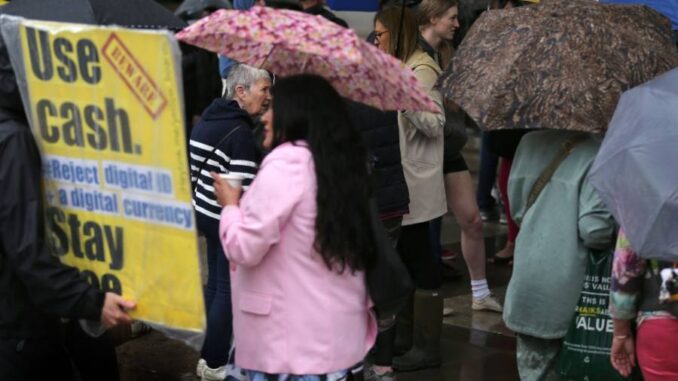
Receive free Digital currencies updates
We’ll send you a myFT Daily Digest email rounding up the latest Digital currencies news every morning.
The writer, an FT contributing editor, is chief executive of the Royal Society of Arts
Driving down the M1 motorway in England recently, I was struck by a spray-painted message across a flyover: “Stop CBDC”. It was the same message I’d seen earlier that week on a placard opposite Downing Street. These are not isolated views. Judging by a petition currently doing the rounds, tens of thousands of people across the UK have put their name to stopping CBDC. For them, CBDC is a scandal.
For the uninitiated, CBDC is central bank digital currency — a digital replacement for physical cash. At least 130 countries around the world are now considering issuing digital cash to their citizens. In the UK a consultation document was issued by the Treasury and the Bank of England in February, to which the above-named petition is the citizen response.
Eight years ago, before CBDC was even an acronym, I wrote in a speech a few (I thought uncontroversial) lines about the possibility of digital cash. Cue howls of derision. A former lecturer of mine wrote a paper entitled “Haldane Cashes Out on Cash”. A petition was mounted to stop me scrapping cash (which I signed, in a failed attempt to lighten the mood).
If nothing else, these responses make clear that cash is much more than a payments technology. It is one of the purest and oldest forms of public good, a symbol of identity and sovereignty. Choices about this public good are, ultimately and rightly, ones for citizens rather than central bankers or cryptographers. They are social, not technological, choices — and sometimes emotional ones.
And the social issues raised by CBDCs are without question real. This includes concerns about the privacy of the currency and about retaining access to cash for those who neither want nor can access CBDC. There are also those who fear deposits might flee from commercial banks to the safe haven of CBDC at the first whiff of financial grapeshot.
Such concerns about financial stability are not to be dismissed. They have caused almost all CBDC designers — and all commercial banks — to conclude that it should pay no interest, since doing so would tend to add to the attraction, and increase the liquidity pressures on banks under duress. This design choice has largely gone unnoticed by the public. This is strange because paying no interest on CBDCs has large and lasting implications for citizens, even though they may not realise it.
Cash is not just a payments medium; it is also a means of financing governments and central banks. Physical cash is an interest-free loan to government, a direct tax on citizens levied in proportion to their cash holdings at a tax rate given by the interest rate. Most people are blissfully unaware they are being taxed in this way. The name of this tax — seigniorage — adds to its mystery and oddity.
The oddity does not end there. Seigniorage is a stealth tax that is both large and highly regressive. Highly regressive because cash is held disproportionately by the poorest and least advantaged in society. Large because, with a global stock of physical currency estimated at around $8.3tn among the world’s biggest economies, and interest rates of say 5 per cent, it amounts to a tax on global citizens of over $400bn each year.
In a world where all cash was physical, central banks and governments could legitimately argue that it was technologically impossible to pay interest. Seigniorage was an unavoidable consequence of providing the public good of physical cash. With the advent of CBDC, those arguments are now otiose. Interest could easily and simply be paid on the CBDC held by citizens, just as it has been for many decades on the CBDC held by banks (whose mystery name is “reserves”).
For many decades, cash has been the only form of money on which no interest rate is paid, disadvantaging those who hold it. With the advent of CBDCs, we could remunerate cash and level the monetary playing field to the benefit of all citizens. Designers of CBDCs have foreclosed on this option, opting to continue levying a large, stealthy, regressive tax on their citizens. They have done so to protect banks and their own finance, both of whom have long benefited from this privilege.
Cash is our money, not theirs. This social choice is one that citizens should be debating and deciding. At present, we are doing neither. At the very point we could be lowering the fiscal burden of a large and regressive stealth tax, governments and central banks are instead choosing to reinforce and raise it. This is a CBDC scandal, if not the one discussed by graffiti artists on motorway flyovers or indeed anyone else.






Be the first to comment